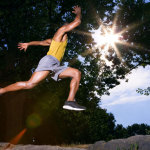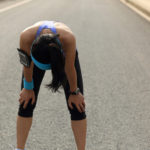The Role of Balance in Sports
What is balance? Does having good balance help my game? How do I train to improve my balance? Balance is established by four different body systems, Vestibular system, Vision, Proprioceptors, and the Hip and Trunk Muscle group.
The vestibular system is the inner ear or the semi-circular canals. These canals are filled with fluid. As we move our head the fluid flows from side to side and front to back. The movement of the fluid stimulates little hairs that send signals to the eye muscles so the eyes can stay focused while our head is in motion. Obviously this is critical for hand eye cordination. In order to achieve better hand eye coordination and to do so while in motion, our vestibular system needs to be highly tuned. Our eyes must stay focused, with detail, so that we can achieve accuracy performing a specific activity, for example hitting a tennis ball over the net. The mechanism that allows this is called the vestibular ocular (eye) reflex. A reflex; is automatic we do not have to think about it. The majority of time dropping a catch, shanking a ball in tennis, or topping a ball in golf are a result of poor contact with the ball. This could be a result of changes in the vestibular ocular reflex. There are several things that could cause this reflex to be dysfunctional. Concussions, inner ear infections, and aging are the three most common causes of a dysfunctional reflex. The vestibular ocular reflex can be trained by a licensed professional such as a physical therapist.
Vision is very important to balance. As noted above, we need to be able to see the target or the ball in the case of tennis while our head is in motion. There is a very small area on the retina that allows us to see details. It is called the fovea. If you hold you thumb at arms length in front of you and focus on the nail, that is the size of the fovea. There are two types of vision tests. The one we have all experiened is an eye chart that is called static vision. The other is rarely tested, which is called dynamic vision. To test your dynamic vision get an eye chart and sit approximately 3-4 feet away. Start turning your head from side to side and then up and down. As you turn your head while focusing on a letter you might start to get dizzy and/or the letter might get difficult to see. Read down the chart and see what level you are still able to see the letters while turning you head. Usually we can lose up to 2 levels. In other words if you have 20/20 vision it may go down to 40/20. Get an eye check up if you have difficult seeing the ball as it could help you balance and your game.
The proprioceptors are sensors in all of our joints and tendons that communicate with your brain and muscles. These small sensors are important to balance. As we change direction on the court, side step, back pedal, or race to a spot, we use these proprioceptors to help us keep our balance. One simple test and exercise is to try to stand on one foot while on something soft like a piece of foam. If you have difficulty staying on the foam it might be your proprioceptors that are unable to give you correct feedback causing you to loose your balance.
Finally, the strength and endurance of specific hip and trunk muscles has been determined through research to be important to body balance. Testing of muscle strength should be performed by a licensed professional physical therapist. Specific exercises can increase the strength and endurance of these muscle groups and help to improve your balance.
As you can see balance is a complicated function involving several different body systems. Agility and quickness might be limited because one of the systems that are important to balance is dysfunctional. Once again an evaluation by a sports specialized physical therapist is essential to determining how to improve you balance and help your game.





